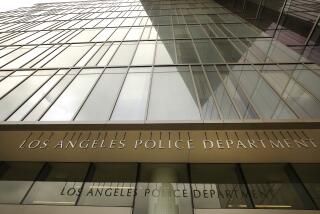LAPD Blames Faulty Training in DNA Snafu
A day after disclosing that the Los Angeles Police Department mistakenly destroyed biological evidence in 1,100 sexual assault cases, LAPD officials blamed the problem on their failure to properly train detectives on maintaining so-called rape kits.
Acting Chief Martin Pomeroy told members of the Police Commission that detectives ordered DNA evidence destroyed because they were unaware that the statute of limitations for rape cases was lengthened in 2001 from six years to 10.
Lt. Horace Frank, an LAPD spokesman, said in an interview that the department has reviewed its procedures in recent weeks to determine what went wrong. He said a memo was issued to detectives when the change took effect, but somehow the information was overlooked.
“We’ve had a lot of new detectives who have inherited unsolved cases,” Frank said. “For some reason they were not made aware.... It’s absolutely a training issue.”
Pomeroy said that the department has formed a task force to look into the issue and that the forensics division has been ordered not to destroy any evidence.
He said the department has revamped its training to make sure officers are informed of changes in state law.
“I believe we’re in a good position to stop the disposing of such evidence,” Pomeroy said.
LAPD officials disclosed to council members Monday that a random sampling of unsolved sexual assault cases dating to 1995 found that detectives had ordered DNA evidence destroyed in 1,100 cases.
The problem came to light in April, when the district attorney’s forensic science director complained that evidence in as many as 4,000 sexual assault cases in Los Angeles County might have been lost or destroyed by law enforcement over the last six years.
DNA, which is obtained from body fluids such as semen, blood and saliva, is the basic identifying material in the human cell and is responsible for transmitting a person’s unique genetic patterns. Foreign DNA collected from a victim in a rape kit is compared with a DNA sample from a suspect to determine if the two match. In many instances, the sample is all a prosecutor needs to make a case against a suspect.
Pomeroy said it is unclear whether any evidence was destroyed in cases that were open or unsolved at the time. However, he said it was possible.
“We have looked into this,” Pomeroy said. “Certainly, in some of those cases we could have had evidence that could have made a difference in the investigation.”
Police Commission President Rick Caruso said in an interview Tuesday that “there is no excuse” for detectives destroying the evidence.
“They didn’t understand what the statute of limitations were,” Caruso said. “They weren’t trained properly. We have been assured that there is a new training program in place and the same mistake won’t happen again.
“It’s unfortunate that it happened in the first place.”
City Councilman Jack Weiss said he will introduce a motion at today’s council meeting instructing the city attorney to work with the LAPD inspector general to ensure that officers are schooled on all law changes.
“The law is constantly evolving,” Weiss said. “There are new statutes enacted all the time. We need to make sure that officers stay on the cutting edge.”
Women’s advocates also called for further scrutiny of department practices.
“The fact that they threw out the kits is unbelievable,” said Karen Polmer, a Los Angeles sexual assault victim who helped lead the charge for lengthening the statute of limitations in rape cases.
“Not only does it impact thousands of women whose cases are unsolved, it also affects the innocent people who may have been convicted of crimes but now will not be able to prove their innocence. It just makes me sick to my stomach.”
Los Angeles County Sheriff’s officials, meanwhile, said they have been auditing their own DNA procedures in recent months and hope to have the results soon. So far, they have found that detectives have properly maintained DNA samples, said Sgt. Dan Scott.
More to Read
Sign up for Essential California
The most important California stories and recommendations in your inbox every morning.
You may occasionally receive promotional content from the Los Angeles Times.










